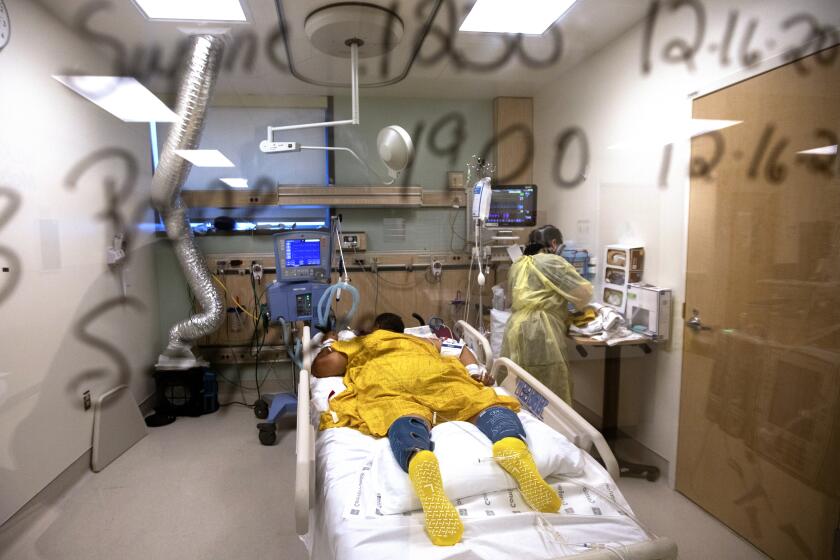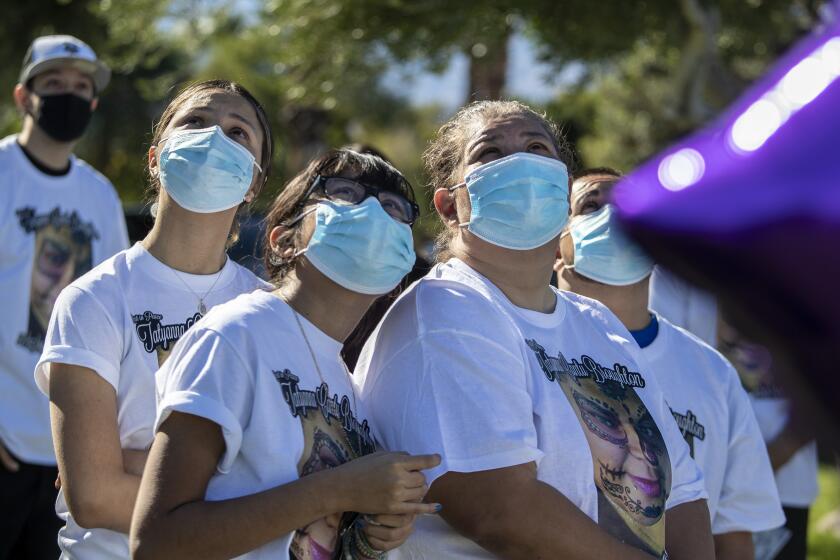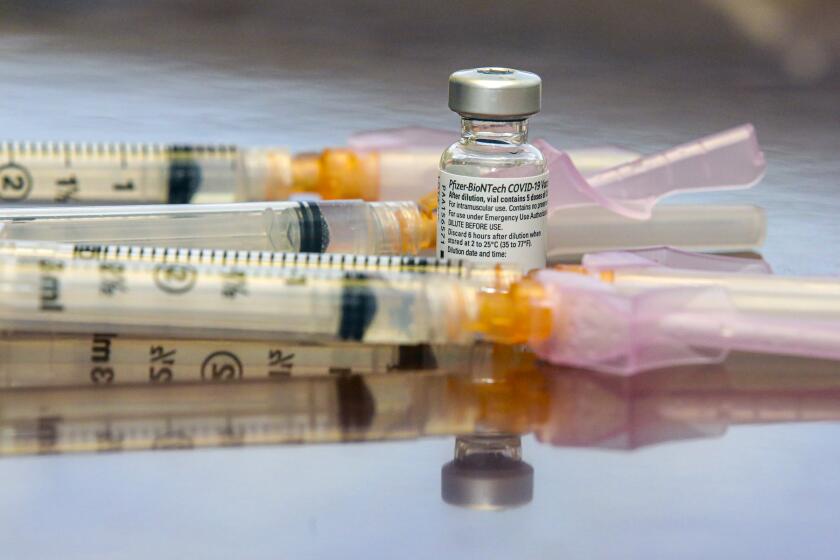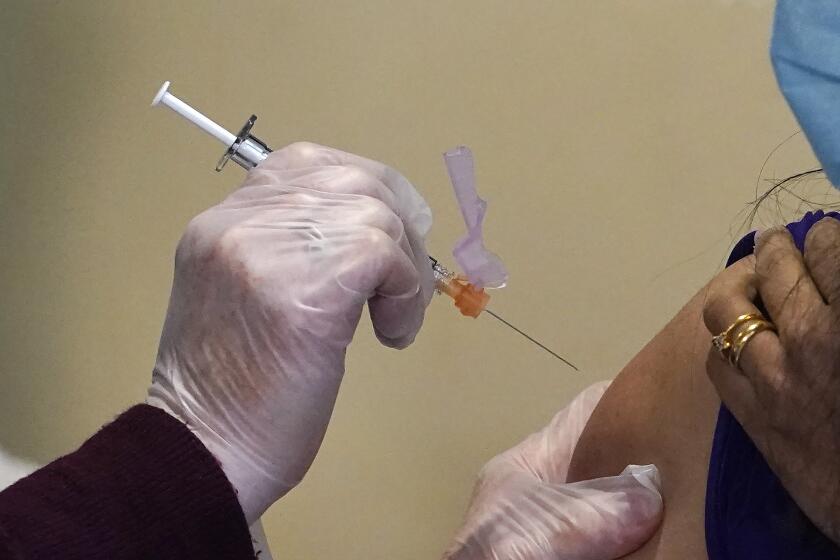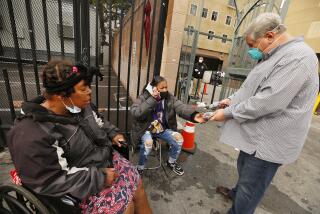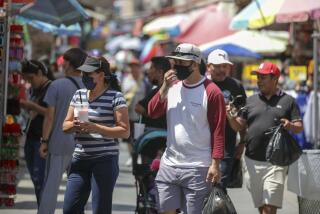L.A. County on verge of becoming COVID-19 epicenter: ‘We are getting crushed’
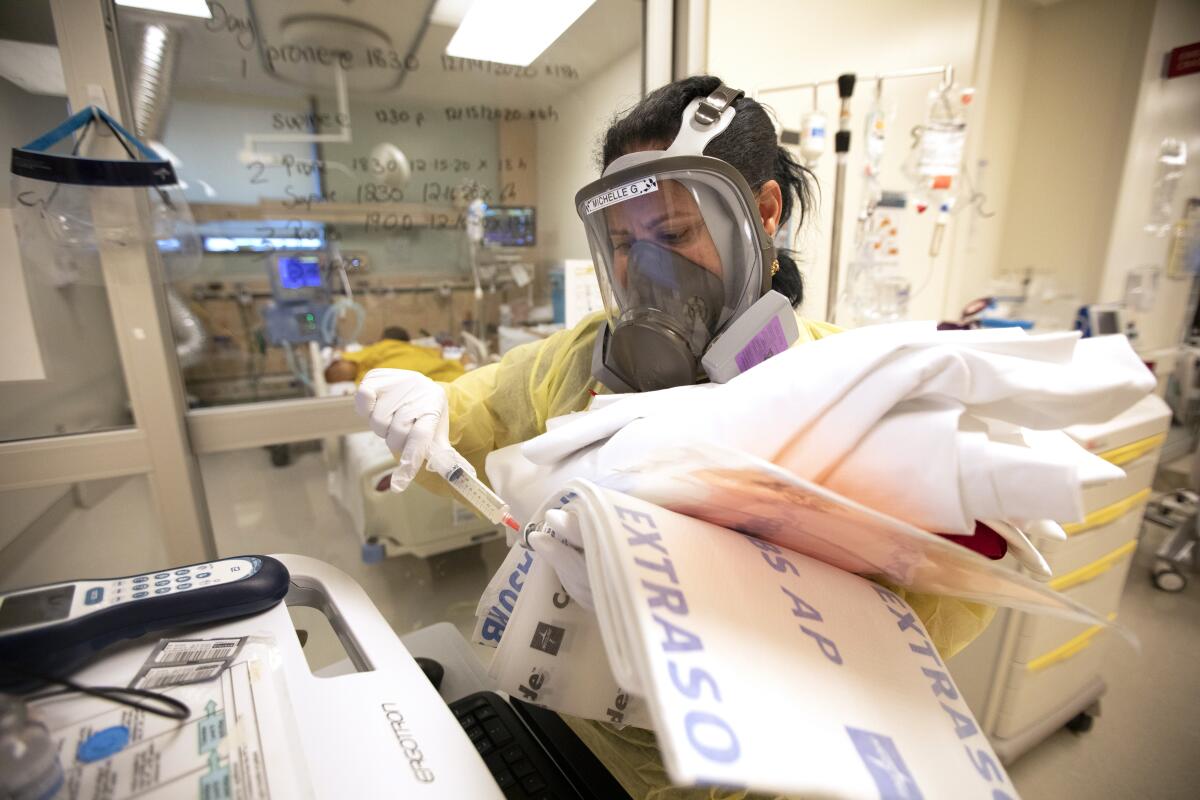
- Share via
Los Angeles County is on the verge of becoming the epicenter of the coronavirus pandemic, a health official said Friday — a dire declaration that comes as Californians are dying from COVID-19 in numbers never seen before.
While the worst wave of the coronavirus has walloped the entire state, the effects have been particularly pronounced in the nation’s most-populous county, where officials warned the healthcare system is already being pushed to its breaking point.
“I’m not going to sugarcoat this: We are getting crushed,” said Dr. Brad Spellberg, chief medical officer at Los Angeles County-USC Medical Center.
Local hospitals are already “critically overcrowded,” he said during a briefing Friday, and “L.A. County is now moving towards becoming the epicenter of the pandemic.”
“We are not at the stage yet at which other parts of the world, including in the United States, have suffered catastrophic consequences. But we are heading in that direction,” he said. “And if we don’t stop the spread, our hospitals will be overwhelmed. If you have a heart attack, if you get into a car accident, if you fall off a ladder or have a stroke, we may not have a bed for you.”
The number of unoccupied beds in Southern California has steadily dropped as hospitals are flooded by unprecedented numbers of COVID-19 patients.
The top concern for many is the county’s intensive care units, which are needed for patients who are critically ill or grievously injured.
More than 1,000 people with COVID-19 are now in L.A. County’s ICUs, quadruple the number from Nov. 1.
There are roughly 2,500 licensed ICU beds countywide, and, as of Friday, officials said only 69 of those were open and available.
Throughout Southern California, a state-defined swath that includes L.A. and 10 other counties, the availability of ICU beds hit 0% Thursday and remained there Friday.
While that doesn’t mean no beds are available at all — as the state uses a weighted formula to ensure that some ICU beds remain open for non-COVID patients — it still underscores the harrowing conditions facing hospitals throughout the region.
The “system is in crisis,” according to Dr. Christina Ghaly, L.A. County’s director of health services.
“When ambulance offload times are up to four hours, six hours, eight hours, that’s a crisis. When hospitals’ emergency departments are full, that’s a crisis. When there’s not sufficiently available beds at the appropriately staffed ratio, that’s a crisis,” she said. “That’s really the point that we’re at.”
Hospitals do have some options to continue providing the highest levels of care possible when ICUs fill up, including moving some patients who would typically be in the intensive care unit to other areas of the hospital, or keeping them in the emergency room for longer than normal.
Even with those strategies in place, though, there eventually may be too many critically ill patients for the limited numbers of ICU doctors and nurses available — leading to greater chances of patients not getting the care they need and, potentially, increases in mortality.
Seven COVID-19 patients. Four hospitalizations. Two funerals. One family.
That’s a particularly chilling prospect, as officials have said they fully expect the hospitalization numbers to continue rising in the weeks to come.
It can take two to three weeks for spikes in coronavirus cases to trigger a corresponding increase in hospitalizations, experts and officials say.
Two weeks ago, California as a whole was averaging about 17,800 new coronavirus cases per day. The average daily caseload has more than doubled since then.
The fear is that a meteoric rise in cases could trigger a fresh wave of hospitalizations — further exacerbating the healthcare crisis.
Already, there are record-high numbers of coronavirus-positive patients hospitalized, 16,019, and in ICUs, 3,447, statewide.
“We haven’t yet seen that hospitalization volume,” Ghaly said, referring to the more recent case counts. “Those patients are still getting to the point where they might need hospital-level care, and that will continue to put strain on the entire healthcare system.”
State officials have previously estimated that 12% of newly diagnosed coronavirus cases are likely to require hospitalization, with 12% of those eventually ending up in the ICU.
By early January, there could be 1,600 to 3,600 COVID-19 patients in need of ICU beds in L.A. County if virus transmission trends remain the same, forecasts say.
Though healthcare professionals have continually honed their ability to care for the sickest COVID-19 patients over the preceding months — learning to avoid, when possible, placing them on mechanical ventilators and to use alternative ways to get more oxygen into the bloodstream; to place people on their bellies to make it easier for them to breathe; and to give patients steroid treatments, for instance — officials and experts have long warned that a severe spike in deaths is an unavoidable consequence of coronavirus infections and hospitalizations snowballing across the state.
More Californians are dying from COVID-19 now than at any other point in the pandemic.
Over 1,500 people lost their lives in just the last week — a staggering number that represents nearly 7% of the state’s more than 22,000 total coronavirus-related fatalities.
The death tolls seen Tuesday, Wednesday and Thursday — 295, 394 and 288, respectively — represent the three deadliest days the state has seen throughout the entire pandemic, according to data compiled by The Times.
“It’s not the flu. This is not something to trifle with,” Gov. Gavin Newsom said this week. “This is a deadly disease, a deadly pandemic.”
Concierge doctors are stocking up with ultra-low-temperature freezers and are being inundated with calls from well-heeled clients looking for an edge in getting the COVID-19 vaccine.
Officials are optimistic, though, that California is nearing a possible turning point. The first doses of COVID-19 vaccine have arrived, and hundreds of thousands more are on the way.
Hundreds of L.A. County healthcare workers have received a vaccine dose so far, and that number is expected to hit 1,500 by the end of Friday and roughly 6,000 by Christmas.
“Our goal is to get to 10,000 workforce vaccinations by the end of the calendar year,” said Dr. Paul Giboney, associate chief medical officer at L.A. County Health Services.
However, widespread inoculation is likely still months away, and given how ferocious and widespread coronavirus transmission is at the moment, officials say it’s vital that residents do all they can in the meantime to keep themselves and their loved ones safe.
Though healthcare workers and hospitals do all they can to treat those infected with COVID-19, “we can only react; we cannot stop the spread,” Spellberg said.
“We need the public to listen to these mitigation strategies to slow the spread or we will completely run out of beds,” he said.
That means wearing masks in public, regular handwashing and staying home when you’re sick. Perhaps most critically, officials say residents should keep physical distance from, and avoid gathering with, those they don’t live with.
Several states say they have been told to expect far fewer doses of the Pfizer COVID-19 vaccine in its second week of distribution.
While that last ask could be a bridge too far for pandemic-weary Californians eager to ring in the winter holidays with family and friends, officials say some seeds of today’s virulent surge were planted around Thanksgiving, when too many traveled or got together in defiance of public health warnings.
Making the same choice this time around, officials warn, will only prolong — and potentially worsen — the surge.
“We are now learning a very painful lesson that, despite how much we want things to go back to normal, this virus is relentless and will continue to spread, make people very ill and, tragically, lead to people passing away,” L.A. County public health director Barbara Ferrer said in a statement. “We can’t afford another holiday season surge that will further overwhelm our already strained hospitals and healthcare staff. We must all work together to prevent as much death as possible.”
The county reported more than 16,000 new cases and 96 new deaths Friday.
Times staff writers Colleen Shalby and Soumya Karlamangla contributed to this report.
More to Read
Sign up for Essential California
The most important California stories and recommendations in your inbox every morning.
You may occasionally receive promotional content from the Los Angeles Times.
